Viking Tribes
Brutish Tribe
The primary tribe on our server is the Brutish Tribe. Although they have never met them, they are very similar in culture to the Hooligans. These vikings learned about 30 years ago to live in harmony with dragons and today like to see themselves as protectors of dragons.
Trader Guild
While not a formal tribe, many of the traders keep themselves free of tribal rivalries by remaining independent with their own leadership structure. Traders follow guidelines and trade rates which they negotiate among themselves every few years at gatherings of their Guild. Occasionally a trader will ally themselves with a particular tribe in exchange for lower trading tariffs or protection from enemies. Some tribes also have their own traders which may or may not follow the rules of a Trader Guild.
The trader guilds sometimes have their own seals for trade agreements but no crests.
Berzerker Tribe
The farthest tribe to the north that the Brutish have ever encountered are the Berzerkers. This feared tribe until recently use skrills as weapons to attack enemy villages and ships and had attempted to grow their empire across the archipelago, however their annexation of territories ended with little explanation not long after they abandoned use of the electrical dragons.
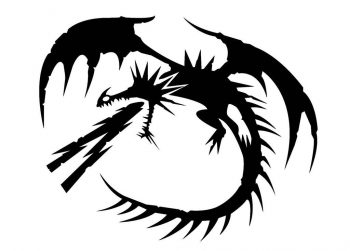
Their crest still remains that of a skrill spitting a bolt of lightning.
Outcasts
Every tribe has its outcasts…and there are several different “Outcast” tribes in the Greenland Sea. Just north if Iceland are the Southern Outcasts. This is essentially a group of exiles from various tribes who were excommunicated from their people due to crimes of various severity. The Outcasts are known to pillage anyone for any reason and can be quite violent and ruthless when they do. In many ways they can be considered the pirates of the cold Scandinavian waters.
The crest for this tribe of outcasts is a fist holding a dripping crown.
Hooligan Tribe
The people of Berk are known as the Hooligans (Or the Hairy Hooligans). Although the name may have been heard among the Brutish villages and some rare goods arrive from their lands on trading vessels, very little is known about this tribe and there is absolutely no interaction between the tribes and characters should NOT know anything about the Berkian Hooligan tribe. [To put timeframe into perspective, Current Chief is Stoick’s Great Grandfather]
This tribe has no crest.
Hunter Tribes
The hunters are a group of tribes which have decided to make their living catching, killing and selling the remains of dragons. Most viking tribes don’t have a problem with this and find the fireproof skin to make good clothing and coverings, meats to taste good, and various other parts of the creatures to come in handy for creating tools and decorations. What doesn’t sell on its own is often discarded or sold for medicinal use in the tradition of “snake oil” salesmen.
Occasionally these tribes will band together against common enemies and to show this allegiance will sometimes fly a unifying symbol of a sword and an arrow piercing a dragon on their sails along with their tribal crest.
Tribe of Ragnar
As their name implies, this is a militant tribe of hunters. They are closely associated with warlords from abroad. As of recently the tribe is now lead by one of these warlords, a germanic knight from the south named Alexandria with a hatred of dragons who quickly rose in the ranks. Her flagship is armored with dragon scale and uses dragon skin for sails.
As the most powerful and largest tribe, Alexandria and the Tribe of Ragnar have a dominant relationship over the other tribes. The tribe calls a protected city on the western coast of Northubria their home port (present day Hull). They are ruthless and sometimes train dragons (using violent methods, not training in the same sense as dragon riders) to do their bidding against other dragons and their enemies.
Their crest is two swords crossed in an X pattern with a pair of arrows forming a +, the four lines joined at the center.
Herleif Tribe
Long ago this tribe resembled the Tribe of Ragnar, but many generations have passed since they gave up their wars against men and began a war with dragons. This does not end their quarrelsome nature and like the Ragnars will often venture south and clash with foreign ships while they hunt dragons. They will occasionally surrender if overpowered.
Tribe of the Magnus
Despite a name implying their greatness, this tribe is nomadic, their entire culture being a fleet of ships which travels from island to island not staying for very long and not keeping more than an occasional outpost to work from as a base. Their hunter ships travel independent from the main fleet and trade their hunts before returning, but do often return to the rest of the tribe to share their ill gotten gains.

These tend to attempt to avoid conflict with other tribes and would rather escape on one ship and abandon the rest than fight to the death against a strong opposing force. There are however very intelligent and inventive people among this tribe and some question the wisdom of their leaders. Internal conflicts have begun which may someday make it a great threat to dragons.
Their crest looks like a fist held upright dripping with blood.
Great and Honorable Order of Ingerman
Founded by Ingar Ingerman this is the only group of hunters which is made up of both a clan and inducted members from any tribe as a sort of fraternity. They are identified by their signature helmet, a small reinforced iron cap with small wings cast from each side. While their primary prey are dramillion which are used in their induction hunt, they do not discriminate when the opportunity arises to take down any dragon. They also despise the idea of dragons and humans living in coexistence and will raid villages where they believe tamed dragons may be present.
Unlike the other tribes, the Order of Ingerman is based in the far north and only on very rare occasion do they stray anywhere close to Dragon’s Rest. Dragons who have encountered them normally come from the north to reach the islands.
Enemy Kingdoms
The Picts of Scotia
Once allies of the Brutish tribe, the prince, Cormac, was promised the hand of Helga Unn for an arranged marriage to unite the tribes. Taking her refusal due to growing responsibilities with Dragon’s Rest as a personal insult, Cormac has convinced his father and several allies to end the peace with the vikings and declare the two nations as enemies.
Frisian Kingdom of Unn
Long ago, the uncle of Helga and Tue Unn, Balsar Unn, was envious of his brother’s ascent to the role of High Chief. After a failed attempt to assassinate his brother Eric, Balsar was exiled from the tribe.
Settling in Frisia (today known as the Netherlands,) near where the territories of the Saxons and the Francs met, he found strong allies among the Franc nobles and became a powerful leader. He now rules a small kingdom on the west edge of Frisia and with the support of his French allies has declared war on his brother and his former people, vowing to take over the tribe even to the point of eliminating all of his kin and their supporters.
Kingdom of Sogn
Kingdom of Hålogaland
Brutish Hierarchy
The following are the important persons of the Brutish tribe:
- Erik Erikson Unn – High Chief of the Brutish Tribe, Chief of Djull
- Erik Unn – Erik & Tue’s father, Retired High Chief
- ?? Unn – Erik & Tue’s Mother, Chieftess Matriarch
- Tue Unn – Former Chief of Dragon’s Rest and Helga’s youngest brother.
- Garrick – Chief’s Advisor of Djull, Tue’s childhood mentor, Elder and healer of the tribe.
- Hrothvir – Chief of the Dragon’s Rest Outpost
- Udar – Chief of Fjallholt
- Arne – Chief of Dyjubofl
- Gorm – Chief of Minetown
- Troels – Chief of Hjallforjt
- Sten – Chief of the Village of Northern Coast
- Njal – Chief of Halsgrof
Brutish Culture and Traditions
The Brutish are not a warlike tribe, however like any other vikings they have been in wars and will occasionally raid the ships and villages of their enemies, and keep their battle abilities and defensive capabilities sharp as their enemies will do the same to them. Their empire spreads along the south-central Scandinavian coastline with major villages providing most of what all villages large and small in this area need.
For the past several years they have attempted to prevent the spread of dragon hunters across their territory as those more villainous tribes have traveled from the south and have begun their own outposts just outside of Brutish territory.
Every Brutish village enjoys any excuse for a feast, often including games, dancing, music, and pageants. These can be for weddings, victories, or just as a way to enjoy each others’ company. Often times a large feast can attract attendees from other villages in the tribe. Holidays are another excuse for gatherings and these include Veizlavar (Spring planting festival), Odinrikr (Summer Harvest Festival honoring Odin), Arferoveizla (Fall Harvest Festival) and the winter festival of Snoggletog.
In many tribes, the village provides one communal meal a day for its residents in a great hall, longhouse, or open pavilion. Any other meals are the responsibility of each family but this one meal provides a way for everyone in the village to interact and remain close while preventing anyone from starving. In some cases this communal meal in itself can be treated like a party to celebrate another successful day and give thanks to Odin.
Brutish Tools & Weapons
Many tools and weapons are standard for all viking communities no matter the tribe. These include axes, hammers, swords, daggers, and bows.
The Brutish have use of useful tools such as pliers and a crude form of adjustable wrench. Basic screw based tools such as C-clamps exist to hold objects together. Coil springs have not been invented and so leaf springs and tension are what cause return action in tools and crude machinery. Screws and bolts do not exist nor do screwdrivers, however rivets, nails and expanding pegs do. Padlocks however have been invented.
The above tools can be used as weapons, the most modern weapons in the viking arsenal being catapults, ballistas, and one of the newest inventions being crude and bulky crossbows. A large improvement over the catapult known as the Trebuchet has been brought to some tribes from the south although building them correctly and firing them accurately is still being learned.
As for everyday tools and supplies, most dishes (plates, bowls, mugs, utensils) would be carved from wood or stone, with the more special-occasion wares being forged from metal. Many mallets and farm tools are also made from wood, sometimes coated in wax or various types of oils to help them to last longer and resist weathering.
Brutish Structures
Heavy timber and wood or slate scale-pattern shingles make up much of the building construction in most Brutish villages. Other building methods include log cabin type construction where notches are cut in the ends of logs to allow them to stack criss-crossed at corners. Mud and small branches are sometimes plastered onto both sides of walls to protect from the cold and after time these can become covered with grass, moss and other thin vegetation. On occasion holes are dug, lined with stone and then buried with only a doorway and air vent exposed, providing a constant temperature and relatively quiet area inside and the look of a dirt mound outside.
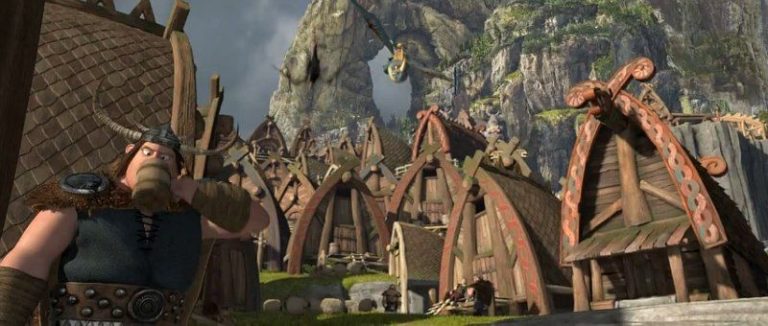
Huts in outposts are often constructed either as long timber cabin-type structures or alternatively using the same techniques as ships – though upside down. Sometimes larger ships are actually flipped upside down and converted into homes or storehouses. Other styles of construction tend to be simple pole barn construction with thatched (dried long grass) roofing.
Some homes have wooden plank floors however most are dirt floors on the lower level, occasionally with straw or grass thrown around to soften the surface.
Huts range in sizes from small dwellings only large enough for a single bed or cot and a few boxes of belongings to large structures which can house a several member family or even multiple families or several different single individuals with a shared living area and separate sleeping rooms. In these cases, sleeping areas are often in a second level which can be a loft or entire floor while eating and lounging areas and an indoor fire pit would be located in the lower ground level. There is a small opening at the top of the building to allow smoke from the central fire to escape.
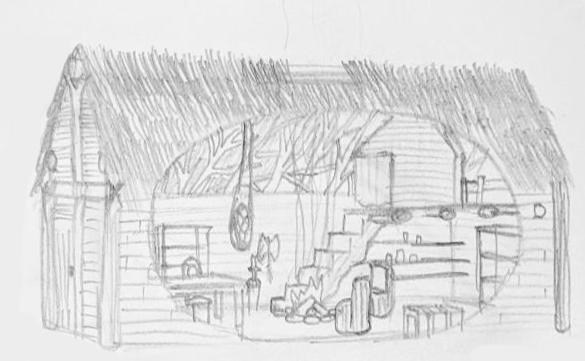
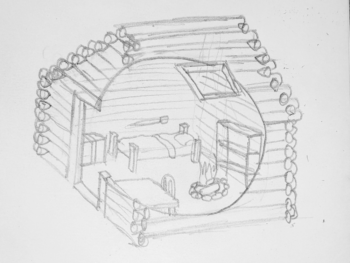
Some dragon riders with smaller huts will build additions or separate structures beside their homes for their dragons to sleep in.
In addition to living areas, structures commonly found in villages include:
- Strong wooden docks for loading and unloading ships. Most villages in the archipelago require ramps from these up to the village due to cliff faces on all sides of the landscape. Djull is an exception to this as its docks are approached by a shallow beach.
- A central hall, either a large building, carved cavern room or a grand longhouse with fireplaces and tables where communal meals and meetings take place.
- Taverns and pubs which are often rather basic in construction with wood floors so that spilled ales and mead can spill through the cracks without forming mud
- Bakeries and shops which can have dirt or wood floors and often have a living area above or behind the work area for the shopkeeper,
- Various storehouses for different types of food and grain, spring houses and root cellars or covered pits to keep food cool and preserved for longer.
- Armory storehouses for storing weapons, arrows, bolts, catapult stones and flammable materials.
- Barns and stables for livestock
- Tall stone guard towers for seeing enemy ships approaching and to provide good angles for archers to defend the village from
- Deep stone wells at multiple locations in the village to provide fresh water.
- In the case of Dragon’s Rest, large wooden platforms overhanging the edges of cliffs to provide places for dragons to land and relax at different levels of the village.
- Water collection towers, where rain water is gathered for use by farmers and dragons are known to sometimes perch and take a drink.
- Dragon’s Rest also has a three story structure with one open side for wild dragons to use as a roost near the village.
- Outhouses…shouldn’t need explaining and rarely need mentioned…

Traders
These independent voyagers travel from village to village exchanging unique items and quality goods between them. Traders are often well informed on the value of absolutely everything so that they can make sure to always come out on the more beneficial side of a bargain. In most cases, they buy for coin and sell for coin – silver and gold being preferable – however they are not opposed to trading an object for an object as long as the value is in their favor.
These nomads will occasionally have a home port, to store their goods and have a solid and safe place to rest when the seas are hairy. For the most part however they prefer the rocking of their ship and do not stay at a port for more than a day or two before shipping off to the next village.
Some traders are part of a particular tribe, and exchange goods between the many villages of that tribe as well as immediate neighbors. Others will travel as far as the winds and currents will take them and make port wherever they feel, sometimes developing routes that take them to the same village once every year or two. These in particular can bring the most rare and valuable objects to trade and provide a connection to other cultures and societies beyond the ‘known world.’
Trader ships are generally oversized longboats with a large upper deck that is arranged like a sales floor when at port and sometimes has a living cabin on one end, and up to two levels of holds below deck where wares are stored. At the very bottom of some ships is a shallow level serving as a bilge reservoir to keep the stores in the lower hold dry from the water seeping through the hull of the ship in between daily pumping to drain it. The entrance to this level is often disguised and some of the more valuable goods (or people or items being smuggled) are kept there to protect them from would-be thieves or inspections.
Hunter Hierarchy
In most cases, hunters are arranged very much like other tribes. Often a chief leads the tribe, and these discuss trade agreements and peace accords with others. There is a unifying agreement between the major hunter tribes and every several months they meet to discuss their hunting territories and trade rates as well as new clients and discoveries. It is known that the hunters have a loose trade agreement with the Roman Empire as well as the Franks and Britons to the south, although they also often clash with these peoples.
Little is known right now regarding who is in charge of the hunters or how they operate.
Hunter weapons and Tools
As it has been said, necessity is the mother of invention. Dragon hunter tribes, as a part of their trade, must contininually overpower and outsmart intelligent and dangerous dragons. Because of this their weapons tend to be somewhat more advanced than that of the more peaceful tribes, and some of their tools would not be needed by those villages.
- Dragon-proof cages took quite a great deal of experimentation, however the correct mixture of ores and heat has provided a metal which dragon fire cannot melt and strong dragons cannot bend enough to unhook a latch from the inside.
- Dragonroot Toxin is invaluable to a hunter. This green paste made by boiling chopped up dragon root until it has the consistency of syrup has no negative effects on humans however if even a small amount enters a dragon’s bloodstream it causes muscle spasms, loss of motor control and concentration, fever, and lethargy for as much as 36 hours. This is often rubbed onto blades and coated onto the tips of arrows and crossbow bolts.
- Harpoons and ballistas are a quick way to take down a stronger dragon, sometimes killing it at the same time. These are most often used for the latter purpose by the Ragnar tribe as they will sometimes skin and process a dragon on ship instead of awaiting port.
- Bolos, net launchers and launched chains are frequently used by hunters to snag dragons from midair.
- Lightweight Armor is often reinforced around more frequently attacked locations (lower stomach, neck, thighs) and made of strong metal plating connected by seamless leather that is all then coated with a paint made of ground dragon scale so that it is fireproof if attacked.)
Brutish Ships
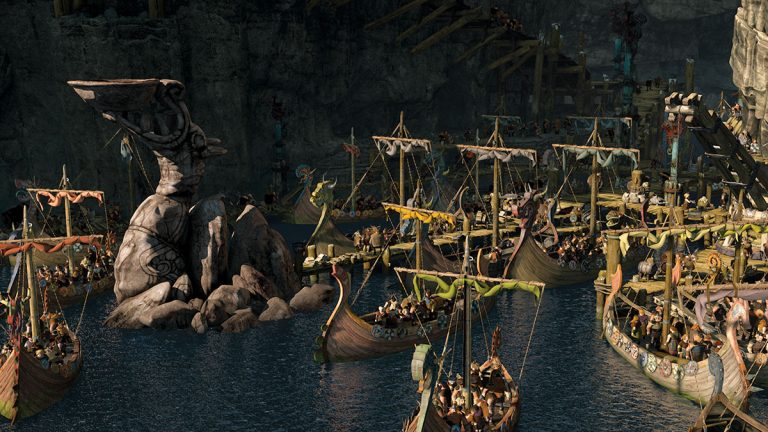
Almost every ship owned by the Brutish tribe is a traditional longship, most built using the Clinker design (overlapping edges of boards). many, especially those use for fishing, have very little internal construction besides the structural supports. This allows for more capacity of fish and cheaper construction for the fisherman to pay for.
Larger ships are built of the same design but scaled up with decks and rooms installed. Occasionally these are also proportionatelywider to make up for the added weight.
Hunter Ships
Hunters need much larger ships due to the number of dragons they wish to transport. (Note, these categories and descriptions apply to Dragon’s Rest but are not necessarily canon to the official HTTYD franchise) The most common ships include:
Scouts and Landing Craft
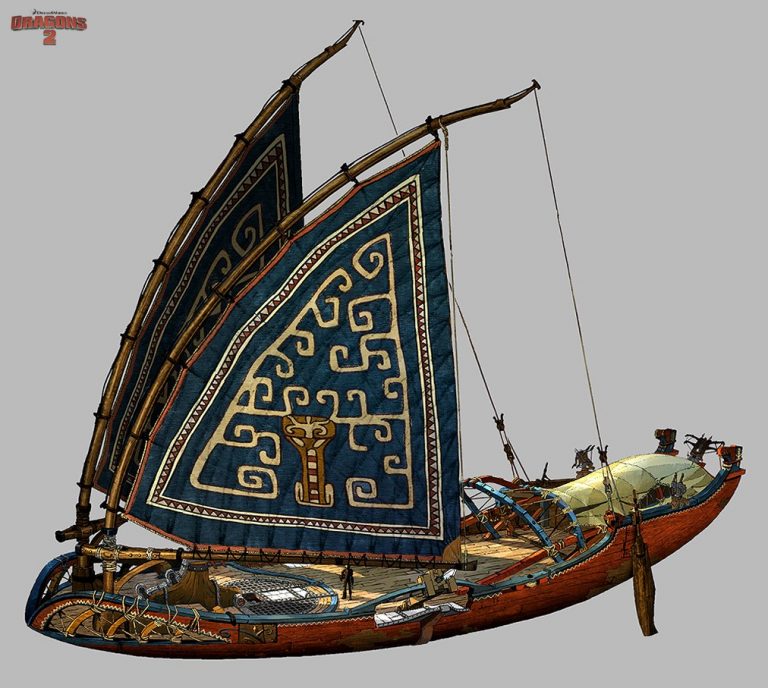
These smaller boats are very fast and capable of surviving on their own without a larger ship or port for days on end, however often are found accompanying larger ships in the fleet only being sent ahead short distances to report sightings or to take hunters on sneak attacks before the main fleet arrives. They are also shallow with very little water displacement allowing them to get close to beaches. They have a crew of 6 and the capacity for 2-3 dragons in the hold below deck. It is this class of ship that Erit son of Erit commanded in HTTYD2.
Attack Ships
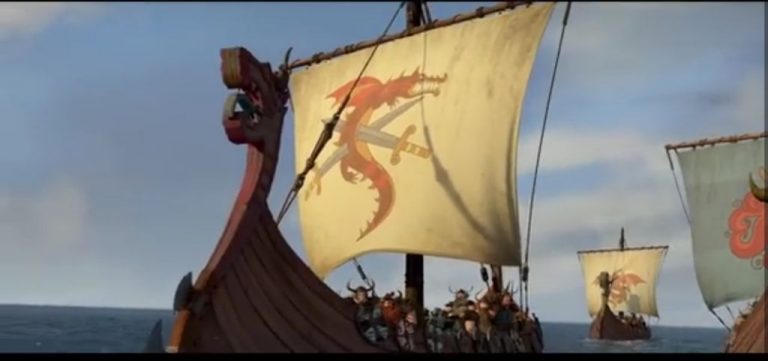
These are very close to the standard Viking longboats, although coming in various sizes and often quite larger. These are often built of stronger, thicker wood than the standard longboats as well. Commonly one or two smaller ships such as those pictured will escort a much larger version of the design but they are all heavily armed for both battle against other ships as well as dragons. The smaller versions will provide fire support and can usually carry one or two dragons transported in cages or chained down to the deck, while the larger ships have holds capable of holding anywhere from 4 to 8 dragons at a time. Depending on the ship’s size it can have a crew of anywhere from 8 to 30 men.
Harvesters

These are the largest ships known to roam the sea, and crossing paths with one by itself is extremely rare. These are a floating village with a crew that can number anywhere from 30 to 50 men. The solid construction and arsenal of standard and heavy siege weaponry makes them difficult to attack. Their holds are capable of holding as many as 20 dragons.
As a major part of their construction, the main ship is flanked by two attached pontoons that appear like miniature ships. These can be used by archers for defense and can be used to more easily lash tidal class dragons to the side of the ship within the water. These are the ships’ primary weakness as they keep the main body of the ship upright, however they are heavily reinforced and nearly impossible to separate from the main ship.
